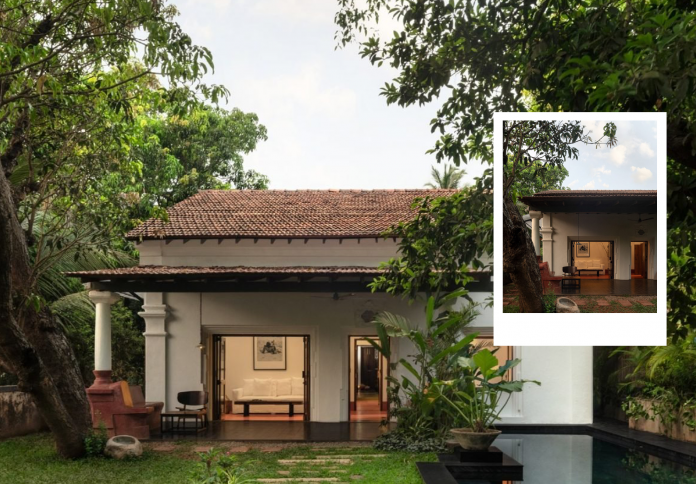The Toybox project by Indian practice Grounded represents a masterful act of adaptive reuse, bringing a 160-year-old Portuguese-style house in the quiet Goan village of Aldona into the twenty-first century. Situated near the banks of the Moira river, the home—which once belonged to the family of the former governor of Portuguese India—retains its historic soul while adopting contemporary function and thermal efficiency. Grounded founder Anjali Mangalgiri led the meticulous restoration, beginning with a detailed documentation of vernacular elements to ensure the original shell, footprint, terracotta tile roof, and traditional façade plaster detailing were preserved. By carefully integrating a new bedroom and modern amenities via an interior courtyard, the design creates a seamless dialogue between the old-world charm of Goan-Portuguese craftsmanship and the demands of modern, sustainable living.
Preservation as a Foundation for Contemporary Living
The core philosophy of the Toybox restoration was an unwavering commitment to historical continuity. The entire process was rooted in preserving the original character of the Goan-Portuguese vernacular. This dedication meant retaining the historic elements that defined the house, ensuring every fluted band, facade plaster detail, and structural wall connected the new design to a rich lineage of craftsmanship. Critically, the original footprint of the main house was retained, along with all existing trees on the site, demonstrating a deep respect for the architectural and ecological context.

The renovation focused on adapting the existing spaces for modern functionality. The original volume was reconfigured to include a living room, a dedicated study, and an open, eat-in kitchen—a nod to contemporary domestic life in what was traditionally a series of compartmentalized rooms. This careful balance of preservation and pragmatic adaptation allowed the home to evolve without erasing its 160 years of history, ensuring its visual presence remained harmonious with the surrounding village streetscape.
A Dialogue Between Old Walls and New Volumes
While the front elevation was diligently kept true to its original form, the architects introduced a strategic new extension at the rear of the house. This volume was essential for accommodating modern amenities, specifically additional bathrooms and a new third bedroom. This new structure was thoughtfully connected to the existing building via a beautiful interior courtyard, which acts as a transition zone and a vital source of light and cross-ventilation for the central areas of the home.

The extension allowed for dramatic architectural statements that would have been impossible within the historic shell. Notably, the west wall’s openings were designed to offer a cathedral-like quality, while the openings on the east side feature a dedicated window seat and host larger apertures. This contrast between the cool, solid, historic masonry of the original house and the new, light-filled additions creates a dynamic spatial storytelling, transforming the home’s circulation into an experiential journey between memory and modernity.
The Palette of Time: Tactile Materials and Earthy Tones
The interior material selection was a deliberate act of continuity, focusing on earthen, tactile finishes that blend seamlessly with the historic structure. The original red oxide floors, a common feature in old Goan homes, were painstakingly restored, their rich, warm color forming the base of the design palette. These floors were paired with breathable lime plaster walls, which lend a rustic texture and assist in natural temperature regulation, a crucial feature in the humid Goan climate.

Complementing these indigenous materials, reclaimed and antique elements were introduced. The preserved roof’s original timber structure was covered in traditional terracotta tiles, while reclaimed teak wood furniture and antique ceramic tiles were used throughout the spaces. Even small elements, such as a traditional prayer niche in the kitchen, were preserved, ensuring every surface, texture, and fixture contributes to a feeling of being rooted in the home’s lived history.
Climate-Responsive Upgrades for Modern Comfort
Beyond aesthetic restoration, a significant aspect of the Toybox renovation was integrating sustainable, climate-responsive features essential for contemporary comfort. While the traditional design elements—such as thick walls and smaller windows—naturally provided some insulation, the architects enhanced the performance for modern living. They addressed the old roof structure, raising and waterproofing it while adding thermal roof insulation to prevent heat gain.

Crucially, the design strategically introduced new and larger windows and doors in specific areas to maximize natural light and facilitate east-west cross-ventilation, which is vital for thermal comfort during the hot season. Furthermore, original small window openings were either retained in their original position or reused in new openings, minimizing waste. This comprehensive approach ensures that the 160-year-old home now functions as a high-performing, energy-efficient residence, demonstrating that heritage architecture can be perfectly aligned with modern eco-friendly standards.










